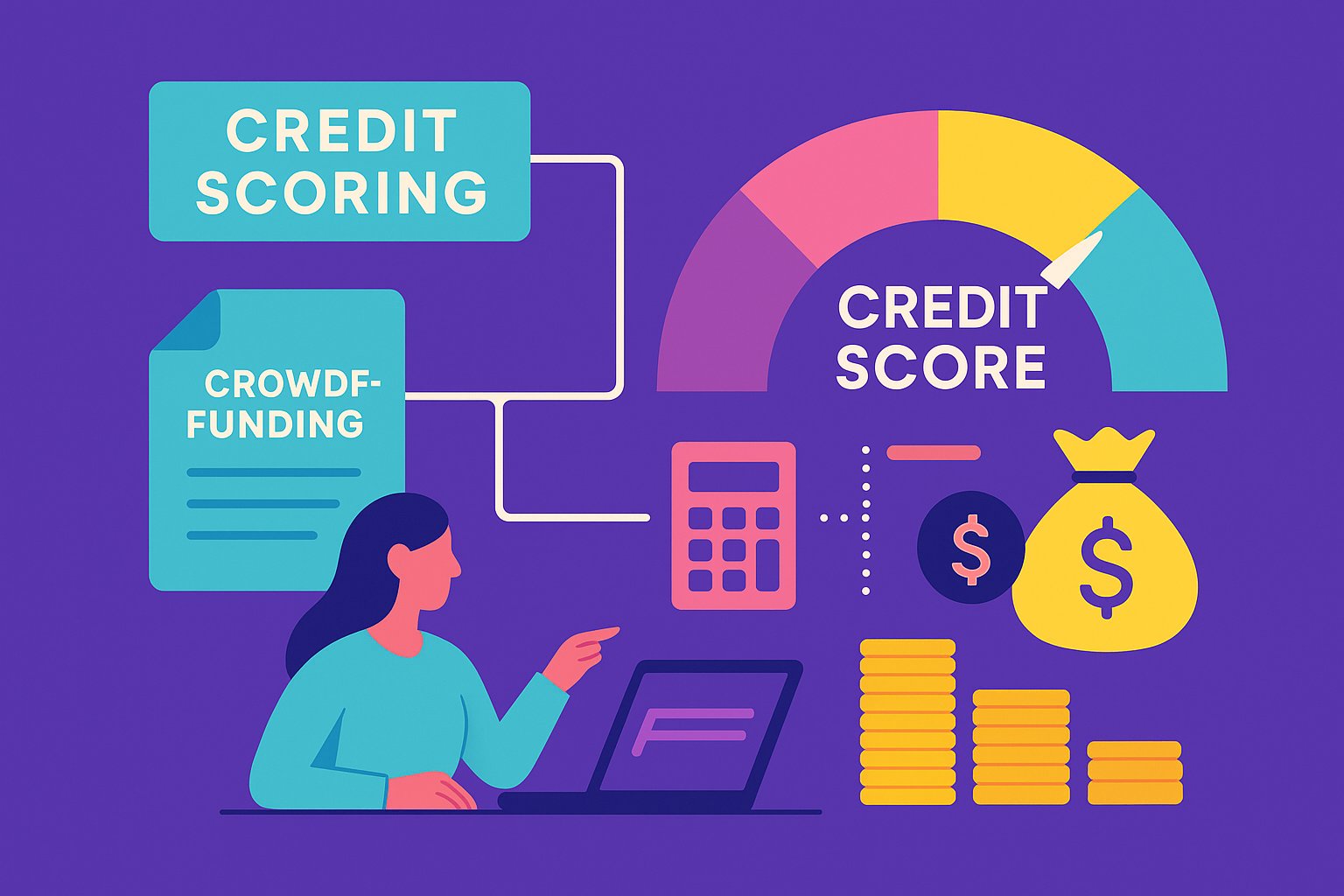Setting the Stage for Responsible Lending
Debt crowdfunding platforms have revolutionized the way borrowers access financing and how investors earn returns. At the heart of every thriving debt-based marketplace is a robust underwriting process that balances borrower access to capital with investor protection. Underwriting may seem like an arcane black box—filled with credit scores, ratios, and algorithms—but at its core, it is a structured journey of assessing risk, verifying information, and ensuring that every loan listing meets rigorous standards. In this opening exploration, we’ll demystify how underwriting processes work in debt crowdfunding, unveiling each critical step that transforms a borrower’s loan request into an investable opportunity for hundreds or even thousands of lenders.
Capturing the Borrower’s Story: The Application Phase
Every underwriting journey begins when a prospective borrower clicks “Apply” on the platform’s website or app. At this stage, platforms collect essential information: personal identifiers, employment history, income sources, existing debts, and the purpose of the loan. The borrower typically uploads supporting documents—recent pay stubs, tax returns, bank statements, and business financials if self-employed. Platforms often provide user-friendly checklists to ensure applicants submit a complete package. This initial data capture is more than administrative; it is the foundation upon which risk evaluation rests. By guiding borrowers to share comprehensive and accurate details from the outset, platforms set the stage for efficient and fair underwriting, minimizing back-and-forth clarifications that can slow down the process.
Verifying the Blueprint: Document Validation and Preliminary Checks
Once a borrower has submitted application materials, the underwriting team moves into document validation mode. Rather than relying solely on automated systems, many platforms blend technology with human oversight. Automated checks verify that uploaded documents are legible, authenticated, and consistent with the borrower’s stated information. For example, bank statement addresses must align with the borrower’s residential address, and tax returns should match reported income figures. Human reviewers step in to spot anomalies that machines may miss—such as signs of doctored documents, unusually large one-time deposits, or discrepancies between stated income and lifestyle indicators. This layer of scrutiny ensures that only legitimate, well-documented requests proceed further.
Quantifying the Risk: Credit Assessment and Score Integration
Credit scores remain a staple measure of risk in underwriting, but modern debt crowdfunding platforms go deeper than a three-digit number. After obtaining a borrower’s consent, platforms pull credit reports from major bureaus and extract key data points: payment history, credit utilization, length of credit history, and any derogatory marks. Some platforms use these raw scores as inputs into proprietary risk models that weigh additional factors—such as recent credit inquiries, frequency of new accounts, or the mix of revolving versus installment credit. Borrowers with spotless credit scores often sail smoothly through this phase, while those with blemishes receive tailored analyses. Underwriters examine the context behind any late payments: Was it a medical emergency, a one-time oversight, or part of a troubling pattern? By marrying traditional credit metrics with nuanced human judgment, platforms strike the balance between quantitative consistency and qualitative fairness.
Unpacking the Debt-to-Income Puzzle
A borrower’s debt-to-income (DTI) ratio is a critical barometer of repayment capacity. Underwriters calculate DTI by dividing the sum of the borrower’s monthly debt obligations—credit card minimums, auto loan installments, student loan payments, and existing mortgages—by their gross monthly income. A DTI below 36 percent typically signals healthy financial breathing room, while a DTI above 43 percent can trigger red flags. Yet savvy underwriters don’t simply apply a universal cutoff; they consider the nature of each debt. For instance, a long-term mortgage with a low interest rate often carries less risk than maxed-out credit cards with double-digit rates. Platforms may adjust DTI thresholds for borrowers with high disposable income or significant savings, providing a pathway for those who have occasional debts but also robust cash reserves. By contextualizing DTI within the borrower’s broader financial picture, the underwriting process remains both precise and flexible.
Weighing Income Stability: Beyond the Pay Stub
Income verification forms a cornerstone of underwriting. Salaried employees typically provide two to three recent pay stubs and a W-2, while self-employed individuals submit profit-and-loss statements, tax returns (often for the past two years), and business bank statements. Underwriters scrutinize these documents for consistency: Do quarterly tax returns align with reported bank deposits? Are there unexplained spikes or drops in income? If a borrower’s earnings fluctuate—common among freelancers or gig economy workers—the underwriting team may require additional context: client contracts, recurring invoicing patterns, or even letters from major clients attesting to ongoing work. For business owners, platforms often examine year-over-year revenue growth and expense patterns to assess whether future cash flows can sustain repayment. This rigorous income vetting ensures that underwriting does not just capture a borrower’s past earnings but also gauges their capacity to generate reliable income moving forward.
Assessing Business Health: The Entrepreneur’s Underwriting Journey
For entrepreneurs and small business owners seeking working capital, underwriting takes on additional layers. Beyond personal credit checks, platforms evaluate the business’s financial health: profit-and-loss statements, balance sheets, and cash flow statements (ideally for the past two full fiscal years). Underwriters probe key performance indicators: gross margins, net income trends, inventory turnover, and accounts receivable aging. If a business shows positive margins but negative cash flow due to slow payers, the underwriting team may require a personal guarantee from the owner or a lien on business assets. In industries where collateral is commonplace—such as equipment financing—appraisals confirm asset values. By blending rigorous business analytics with entrepreneurial context, platforms ensure that loans to businesses rest on sound fiscal footing and realistic growth projections.
Crafting the Risk Score: Proprietary Algorithms at Work
One defining feature of leading debt crowdfunding platforms is proprietary risk-scoring algorithms. These bespoke models often integrate a blend of traditional credit factors, alternative data sources, and platform-specific performance metrics. For example, a platform may layer in variables like education level, geographic region, or even social media sentiment for certain borrower categories. Machine learning techniques—such as decision trees, random forests, or gradient boosting—analyze historical loan performance to pinpoint the strongest predictors of default. The result is a composite risk score tailored to the platform’s unique borrower population. Rather than relying solely on generic credit bands, these custom models offer a finer-grained separation of risk tiers, enabling platforms to price loans more accurately and match investors with borrowers who meet their specific return and risk appetites.
Assigning Interest Rates: The Yield-Risk Equation
Once underwriters establish a risk score, the next stage is translating that assessment into tangible loan terms—most notably, the interest rate. Platforms typically maintain predetermined rate tiers pegged to risk bands: the lowest-risk borrowers secure the most competitive rates, while higher-risk borrowers pay correspondingly higher spreads. This dynamic pricing model ensures that investors receive compensation commensurate with risk. Interest rates also factor in loan term lengths: shorter-duration loans often carry lower rates because the time horizon for potential default is briefer. Underwriters calibrate rates not only to cover expected losses (derived from historical default rates for each risk segment) but also to absorb platform operating costs and desired profit margins. By fine-tuning this yield-risk equation, platforms create a marketplace where borrowers gain access to capital at fair prices and investors enjoy risk-adjusted returns that mirror their preferences.
Navigating Collateral and Guarantees: Strengthening Underwriting Safety Nets
While many debt crowdfunding loans are unsecured, certain loan categories—particularly small business or equipment financing—may require collateral or personal guarantees. Collateral serves as tangible security: underwriters appraise equipment, real estate, or inventory to ensure its market value sufficiently covers the loan balance. A conservative loan-to-value (LTV) ratio—often capped between 70 and 80 percent—allows for potential depreciation or market fluctuations. When collateral is scarce or the borrower’s credit profile falls just below the platform’s ideal thresholds, personal guarantees offer an added layer of protection. In such cases, the borrower pledges personal assets (home, vehicles, or other high-value items) as backup security. Underwriters review the feasibility of collateral liquidation and legal enforceability of personal guarantees, ensuring that investors have recourse if the borrower defaults. This layered approach to security reduces losses, bolstering investor confidence and broadening access to capital for borderline-credit applicants.
The Final Green Light: Underwriting Approval and Listing
After navigating each assessment pillar—credit, income, business health, proprietary risk scoring, and collateral review—underwriters make the ultimate decision: approve, decline, or conditionally approve with modifications. Conditional approvals may come with stipulations, such as requiring borrowers to pay off a specific high-interest credit card before disbursal or mandating a co-signer for added assurance. Once the underwriting team signs off, the loan transforms into a fully baked listing on the platform. Prospective investors can then review anonymized borrower summaries—highlighting credit grades, purpose of funds, loan term, rate, and any collateral details. Many platforms enrich these listings with aggregate statistics: number of funded loans in that grade, historical default rates, and average time to full funding. This transparency empowers investors to make data-driven decisions, knowing that each listing represents a meticulously underwritten opportunity.
Continuous Monitoring: Safeguarding Loan Health Post-Approval
Underwriting does not end when the loan is funded. Platforms often institute ongoing monitoring protocols to flag emerging risks. Automated systems track payment behaviors—identifying early signs of delinquency, such as a borrower being just one day late. When late payments occur, servicers typically initiate outreach—reminding borrowers of upcoming due dates or offering hardship programs if genuine financial distress arises. In business lending, platforms may require quarterly or semi-annual financial updates, monitoring revenue and expense trends. For collateralized loans, periodic reappraisals may be triggered if market valuations shift dramatically. This continuous vigilance ensures that minor hiccups do not spiral into full-blown defaults. Moreover, platforms may aggregate performance data over time, feeding new insights back into underwriting models to refine risk scoring and adapt to emerging economic conditions.
Evolving Underwriting: Embracing Innovation and Adaptation
As debt crowdfunding matures, underwriting processes evolve in step with technological advances and shifting market dynamics. Artificial intelligence and machine learning continue to refine risk scoring, uncovering patterns that humans alone might overlook. Alternative data sources—such as utility payment histories, mobile phone usage, or psychometric assessments—offer fresh dimensions to borrower profiles, extending credit access to thin-file applicants. Real-time bank account data, accessed through secure APIs, allows platforms to monitor ongoing cash flows with unprecedented immediacy. Regulatory changes also shape underwriting practices, necessitating greater transparency and consumer protections, especially in cross-border lending or new asset classes like renewable energy financing. Forward-thinking platforms incorporate these innovations, ensuring that underwriting remains both rigorous and responsive—delivering fair outcomes for borrowers while safeguarding investor capital in an ever-changing financial ecosystem.
Underwriting in debt-based crowdfunding is far from a monolithic check-the-box exercise. It is a dynamic tapestry of data analysis, human judgment, and technological innovation—each thread ensuring that borrower access to capital does not compromise investor protection. From the borrower’s first click on “Apply,” through meticulous document validation, credit assessments, income verification, risk scoring, and collateral review, to final approval and ongoing monitoring, underwriting shapes the entire marketplace experience. By understanding how these processes intertwine, borrowers can prepare stronger applications, and investors can make more informed allocations. As the industry continues to evolve, underwriting will remain its beating heart—fostering responsible lending, fueling entrepreneurial dreams, and powering the growth of debt crowdfunding on a global stage.




